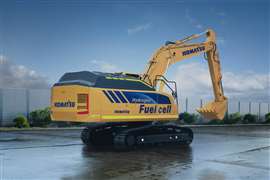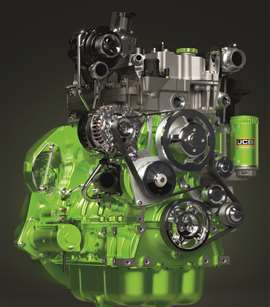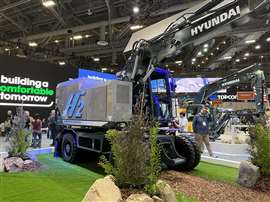Will hydrogen fuel cells make it into construction equipment?
10 November 2023
 Komatsu’s new mid-sized concept excavator is powered by a hydrogen fuel cell. Photo: Komatsu
Komatsu’s new mid-sized concept excavator is powered by a hydrogen fuel cell. Photo: Komatsu
In addition to battery-electric machines, construction equipment OEMs and engine manufacturers are racing to develop new engine technologies using hydrogen as a fuel.
So far, hydrogen internal combustion engines (ICE) are showing promise, with several companies unveiling plans to produce dedicated H2 or fuel-agnostic ICE engines (among them JCB, Perkins and Cummins).
But the debate over the suitability of another form of hydrogen - hydrogen fuel cells - for off-highway applications continues.
Fuel cells involve feeding compressed hydrogen gas from a carbon-fibre reinforced fuel tank into a fuel cell stack that combines oxygen and hydrogen to generate electricity for an electric motor, rather than combusting it.
Whether they are likely to make their way into the construction equipment of the future, as the industry continues on its path to decarbonisation, depends on who you ask.
JCB: ‘Too expensive’
That was illustrated during the recent Diesel Progress Summit in Louisville, USA - organised by KHL’s Diesel Progress magazine - where representatives from power solutions company Volvo Penta and British construction equipment manufacturer JCB offered diverging views on the matter.
Chris Giorgianni, vice president, product, JCB North America told a round table audience that the company was committed to electric machines and machines with hydrogen combustion engines but had ruled out fuel cells.
 JCB is one of several engine manufacturers preparing to go to market with hydrogen engines as soon as next year. (Photo: JCB)
JCB is one of several engine manufacturers preparing to go to market with hydrogen engines as soon as next year. (Photo: JCB)
He said, “We do see the value of electric, being zero emissions and low noise. But there disadvantages. They’re very expensive: some equipment can be nearly two times the cost of its diesel counterpart. And you’ve got the challenge with weight as well. Weight works to your advantage on the compact side, but as you move up the range, weight becomes a problem, especially if you want larger battery-powered pieces of equipment.
“You’re also dependent on a critical mineral supply in areas where the US doesn’t have as much influence so the supply chain could be problematic in the future. Then there is the access to electricity. In an urban environment electric makes sense - you typically will have access to lots of fuel sources. But as you move to brown and greenfield sites, you don’t.”
Taking those factors into consideration, Giorgianni said that JCB looked at fuel cells and built a few larger excavators powered by fuel cells.
While the company found that while the machines did not necessarily produce lower noise levels, they had “better noise quality” and could be refuelled quickly as well as producing low emissions.
But the major disadvantage was cost, Giorgianni.
He said, “It’s very expensive. If you look at a larger excavator, you’re putting upwards of $100,000 worth of costs into the machine. We asked ourselves, is something our customers are willing to willing to accept? JCB also acquired a few fuel cell-powered London buses and we tore the fuel cell systems apart. We found a lot of membranes have been replaced and we started thinking about our job sites and how practical that’s going to be to change on the job site. We didn’t feel it to be a practical solution.”
He added that hydrogen fuel cells required special coolants that could easily be confused with other coolants if machines with different engine types were all being used on a single site.
“We really felt from a fuel cell standpoint that although the technology is great, we didn’t feel to be practical in our environment,” Giorgianni concluded.
JCB has instead focused its efforts on hydrogen combustion engines. The company’s hydrogen ICEs are already powering prototype backhoe loaders and Loadall telescopic handlers and the company also recently unveiled its own designed and built mobile refuelling bowser for the machines.
Volvo Penta: ‘We full intend to offer fuel cells’
Giorgianni’s comments contrasted with those of another speaker at the Diesel Progress Summit, Darren Tasker, vice president, industrial sales, Volvo Penta of the Americas.
Tasker said that Volvo Penta expected there to be a blend of technologies to power the engines of the future.
 Hyundai’s14-ton HW155H prototype hydrogen fuel cell-powered excavator. (Photo: KHL staff)
Hyundai’s14-ton HW155H prototype hydrogen fuel cell-powered excavator. (Photo: KHL staff)
On hydrogen, he said, “This is clearly going to be a strong technology of the future. Today. We have our hydrogen-diesel dual-fuel engine. In 18 months to two years’ time, we will launch a natural gas engine. This is for the evolution of the hydrogen technology. That natural gas engine will be full spark ignition and the next step along that line will be to have a 100% hydrogen spark engine range.
“The next step is the fuel cell. And of course, we are not just working on the technology side of hydrogen being able to be used in off-highway and power generation applications, we are looking at how we can effectively work with hydrogen suppliers to provide green hydrogen in alignment with our 2050 objectives. So it’s a technology development path but it’s also a fuel availability development path that I think not just Volvo but a number of supply chain power train suppliers are on that path.”
When asked whether he regarded fuel cells as suitable for off-highway applications, given the debate around the topic, Tasker said, “We see the fuel cells that we are developing as being robust enough for off-highway applications. It can be a standalone fuel source but it is going to be more effective if it is used with batteries.
“The rate of change is going to be easier to accommodate if you want to go from zero to 100% load with energy storage on board too. But certainly fuel cells will be robust enough. The fuel cells that we are developing, we fully intend to offer it for off-highway applications.”
New business models required
However, Tasker did acknowledge that there was work to be done to assist customers with the high capital cost involved in new forms of technology.
He added, “As power train providers, we are going to need to help customers make the transition successfully. We know that there is a high tariff to pay for this technology. It’s an expensive technology, significant R&D going into developing it.
“The early adopters are going to be challenged with [the question of] how do we commercialise this? And there we are going to have to look at different business models. How do we charge for energy as a service rather than the hardware? How do we look at leasing options? How do we look at reducing that tariff of employing and getting the energy into operation while offsetting the cost over a period of time against lower operational costs?”
Complementary technologies
Also speaking at the Summit, Jim Nebergall, general manager, hydrogen engines, Cummins, said the company was pursuing both types of technology.
“We don’t really see this as fuel cells or engines. They are are quite complementary. Filling the piece of equipment is the same for a fuel cell or an engine. The production and distribution of the fuel can be complementary. It is rare you have two technologies that are so different – an engine and a fuel cell – that can use the same fuel. So having two options will help build out that infrastructure and drive demand.”
Paul Mercurio, US sales manager, Liebherr fuel injection systems also said that he expected fuel cells to be “part of the mix”.
That was particularly the case for larger machines where Mercurio said Liebherr also still sees the need for internal combustion engines fuelled by diesel, biodiesel and hydrogen.
He added that there also some challenging applications like mining trucks, large earthmoves and bulldozers that operate in extreme conditions where “battery electrics may not be able to live up to the full potential required”.
He added, “At the same time there’s applications here for fuel cells as well. There are some concerns with the fuel cells in terms of the purity of the hydrogen that is used in a fuel cell has to be very high and on job sites like this it is very dirty and dusty. This is something that needs to be considered when refuelling on site and also keeping the fuel cells clean so they operate properly.”
STAY CONNECTED




Receive the information you need when you need it through our world-leading magazines, newsletters and daily briefings.
POWER SOURCING GUIDE
The trusted reference and buyer’s guide for 83 years
The original “desktop search engine,” guiding nearly 10,000 users in more than 90 countries it is the primary reference for specifications and details on all the components that go into engine systems.
Visit Now
CONNECT WITH THE TEAM










